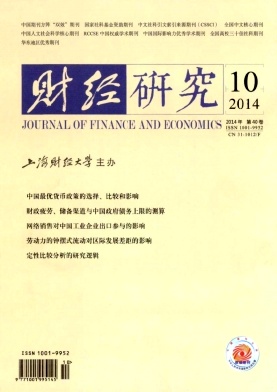南北贸易、产权保护与技能偏向性技术进步——论产权保护是否存在门槛效应
财经研究 2014 年 第 40 卷第 10 期, 页码:59 - 70
摘要
参考文献
摘要
技能偏向性技术进步是发达国家工资变化的主要原因,而发展中国家产权保护的强弱程度决定了南北贸易促进技能偏向性技术进步的方向,进而影响发达国家的工资变化,即产权保护具有门槛效应。文章通过建立内生技术创新模型研究了产权保护在南北贸易促进技能偏向性技术进步过程中的门槛效应。研究发现,当产权保护程度达到门槛值之前,南北贸易将促进高技能偏向性技术进步;当产权保护程度达到门槛值之后,南北贸易将促进低技能偏向性技术进步。利用1995-2007年的数据验证了理论模型中的门槛效应,结果表明,产权保护程度存在3个门槛值,随着产权保护程度的增强,南北贸易对促进技能增强型技术进步的影响先上升后下降,技能增强型技术进步在2002年之前表现为高技能偏向性,而在2002年之后则表现为低技能偏向性。因此,发展中国家提高产权保护程度有利于缓解发达国家的工资差距和南北国家间的贸易摩擦。
[1]胡凯,吴清,胡毓敏.知识产权保护的技术创新效应——基于技术交易市场视角和省级面板数据的实证分析[J].财经研究,2012,(8):15-25.
[2]樊纲,王小鲁,朱恒鹏.中国市场化指数——各地区市场化相对进程2011年报告[M].北京:经济科学出版社,2011.
[3]杨飞.南北贸易与技能偏向性技术进步——兼论中国进出口对前沿技术的影响[J].国际经贸探索,2014,(1):4-16.
[4]余长林,王瑞芳.发展中国家的知识产权保护与技术创新:只是线性关系吗?[J].当代经济科学,2009,(3):92-100.
[5]Acemoglu D.Directed technical change[J].Review of Economic Studies.2002,69(4):781-809.
[6]Acemoglu D,Akcigit U.Intellectual property rights policy,competition and Innovation[J].Journal of the European Economic Association,2012,10(1):1-42.
[7]Acemoglu D,Gancia G,Zilibotti F.Offshoring and directed technical change[R].NBER Working Papers No.18595,2012.
[8]Aghion P,Bloom N,Blundell R,et al.Competition and innovation:An inverted-U relationship[J],The Quarterly Journal of Economics,2005,102(2):701-728.
[9]Aghion P,Harris C,Howitt P,et al.Competition,imitation and growth with step-by-step innovation[J].Review of Economic Studies,2001,68(3):467-492.
[10]Aghion P,Howitt P.The economics of growth[M].Cambridge:MIT Press,2009.
[11]Autor D,Dorn D.The growth of low-skill service jobs and the polarization of the U.S.labor market[J].American Economic Review,2013,103(5):1553-1597.
[12]Autor D,Dorn D,Hanson G.The China syndrome:Local labor market effects of import competition in the United States[J].American Economic Review,2013,103(6):2121-2168.
[13]Bloom N,Draca M,Reenen J.Trade induced technical change?The impact of Chinese imports on Innovation,IT and productivity[R].NBER Working Paper No.16717,2011.
[14]Beaudry P,Green D A,Sand B.The great reversal in the demand for skill and cognitive tasks[R].NBER Working Paper No.18901,2013.
[15]Gancia G,Bonfiglioli A.North-South trade and directed technical change[J].Journal of International Economics,2008,76(2):276-295.
[16]Doms M,Lewis E.Labor Supply and personal computer adoption[R].Federal Reserve Bank of Philadelphia Working Paper No.06-10,2006.
[17]Eicher T,Penalosa C.Endogenous strength of intellectual property rights:Implications for economic development and growth[J].European Economic Review,2008,52(2):237-258
[18]Hansen B.Sample splitting and threshold estimation[J].Econometrica,2000,68(3):575-603.
[19]Helpman E.Innovation,imitation,and intellectual property rights[J].Econometrica,1993,61(6):1247-1280.
[20]Falvey R,Foster N,Memedovic O.The role of intellectual property rights in technology transfer and economic growth:Theory and evidence[R].UNIDO Working Papers,2006.
[21]Fan J,Gillan S,Yu X.Innovation or imitation?The role of intellectual property rights protection[J].Journal of Multinational Financial Management,2013,23(3):208-234.
①已有研究表明产权保护与技术创新的关系还不确定,除了倒U形关系,Helpman(1993)认为严格的产权保护会阻碍技术创新,不过多数文献如Falvey等(2006)和Fan等(2013)认为产权保护能够促进技术创新。
①发达国家间贸易依然是国际贸易的主要形式,2001年以后中国与发达国家间贸易急剧增加;因此,许多学者开始研究中国与发达国家间贸易对发达国家经济的影响,如Bloom等(2011)和Autor等(2013)。这也是本文选择中国样本作为发展中国家代表的原因。
①门槛值T≤3.575的阶段,进口和出口的系数不显著。
①结合下文表4的估计结果,发展中国家产权保护的完善将促使发达国家的企业将更多地研发低技能偏向性技术。
②WH/WL为高低技能劳动的工资比。通过本文的理论模型也可推出这一定义的原理,限于研究目的和篇幅,这里不再列出。
①本文的估计表明,表4中列(1)-列(3)在这两个时间段内,IT价格指数的系数均为负,列(1)-列(3)的分段估计结果并未列出。
[2]樊纲,王小鲁,朱恒鹏.中国市场化指数——各地区市场化相对进程2011年报告[M].北京:经济科学出版社,2011.
[3]杨飞.南北贸易与技能偏向性技术进步——兼论中国进出口对前沿技术的影响[J].国际经贸探索,2014,(1):4-16.
[4]余长林,王瑞芳.发展中国家的知识产权保护与技术创新:只是线性关系吗?[J].当代经济科学,2009,(3):92-100.
[5]Acemoglu D.Directed technical change[J].Review of Economic Studies.2002,69(4):781-809.
[6]Acemoglu D,Akcigit U.Intellectual property rights policy,competition and Innovation[J].Journal of the European Economic Association,2012,10(1):1-42.
[7]Acemoglu D,Gancia G,Zilibotti F.Offshoring and directed technical change[R].NBER Working Papers No.18595,2012.
[8]Aghion P,Bloom N,Blundell R,et al.Competition and innovation:An inverted-U relationship[J],The Quarterly Journal of Economics,2005,102(2):701-728.
[9]Aghion P,Harris C,Howitt P,et al.Competition,imitation and growth with step-by-step innovation[J].Review of Economic Studies,2001,68(3):467-492.
[10]Aghion P,Howitt P.The economics of growth[M].Cambridge:MIT Press,2009.
[11]Autor D,Dorn D.The growth of low-skill service jobs and the polarization of the U.S.labor market[J].American Economic Review,2013,103(5):1553-1597.
[12]Autor D,Dorn D,Hanson G.The China syndrome:Local labor market effects of import competition in the United States[J].American Economic Review,2013,103(6):2121-2168.
[13]Bloom N,Draca M,Reenen J.Trade induced technical change?The impact of Chinese imports on Innovation,IT and productivity[R].NBER Working Paper No.16717,2011.
[14]Beaudry P,Green D A,Sand B.The great reversal in the demand for skill and cognitive tasks[R].NBER Working Paper No.18901,2013.
[15]Gancia G,Bonfiglioli A.North-South trade and directed technical change[J].Journal of International Economics,2008,76(2):276-295.
[16]Doms M,Lewis E.Labor Supply and personal computer adoption[R].Federal Reserve Bank of Philadelphia Working Paper No.06-10,2006.
[17]Eicher T,Penalosa C.Endogenous strength of intellectual property rights:Implications for economic development and growth[J].European Economic Review,2008,52(2):237-258
[18]Hansen B.Sample splitting and threshold estimation[J].Econometrica,2000,68(3):575-603.
[19]Helpman E.Innovation,imitation,and intellectual property rights[J].Econometrica,1993,61(6):1247-1280.
[20]Falvey R,Foster N,Memedovic O.The role of intellectual property rights in technology transfer and economic growth:Theory and evidence[R].UNIDO Working Papers,2006.
[21]Fan J,Gillan S,Yu X.Innovation or imitation?The role of intellectual property rights protection[J].Journal of Multinational Financial Management,2013,23(3):208-234.
①已有研究表明产权保护与技术创新的关系还不确定,除了倒U形关系,Helpman(1993)认为严格的产权保护会阻碍技术创新,不过多数文献如Falvey等(2006)和Fan等(2013)认为产权保护能够促进技术创新。
①发达国家间贸易依然是国际贸易的主要形式,2001年以后中国与发达国家间贸易急剧增加;因此,许多学者开始研究中国与发达国家间贸易对发达国家经济的影响,如Bloom等(2011)和Autor等(2013)。这也是本文选择中国样本作为发展中国家代表的原因。
①门槛值T≤3.575的阶段,进口和出口的系数不显著。
①结合下文表4的估计结果,发展中国家产权保护的完善将促使发达国家的企业将更多地研发低技能偏向性技术。
②WH/WL为高低技能劳动的工资比。通过本文的理论模型也可推出这一定义的原理,限于研究目的和篇幅,这里不再列出。
①本文的估计表明,表4中列(1)-列(3)在这两个时间段内,IT价格指数的系数均为负,列(1)-列(3)的分段估计结果并未列出。
引用本文
杨飞, 程瑶. 南北贸易、产权保护与技能偏向性技术进步——论产权保护是否存在门槛效应[J]. 财经研究, 2014, 40(10): 59–70.
导出参考文献,格式为:





 8174
8174  4306
4306

